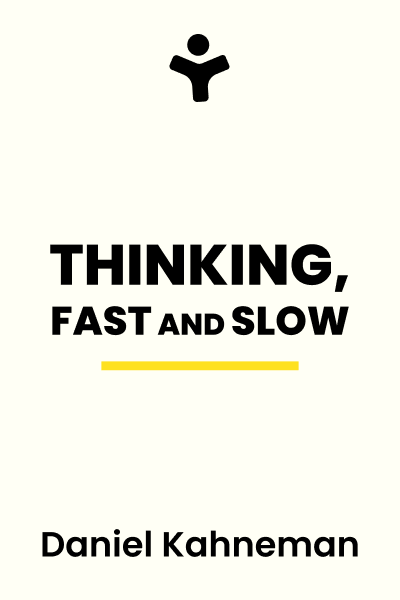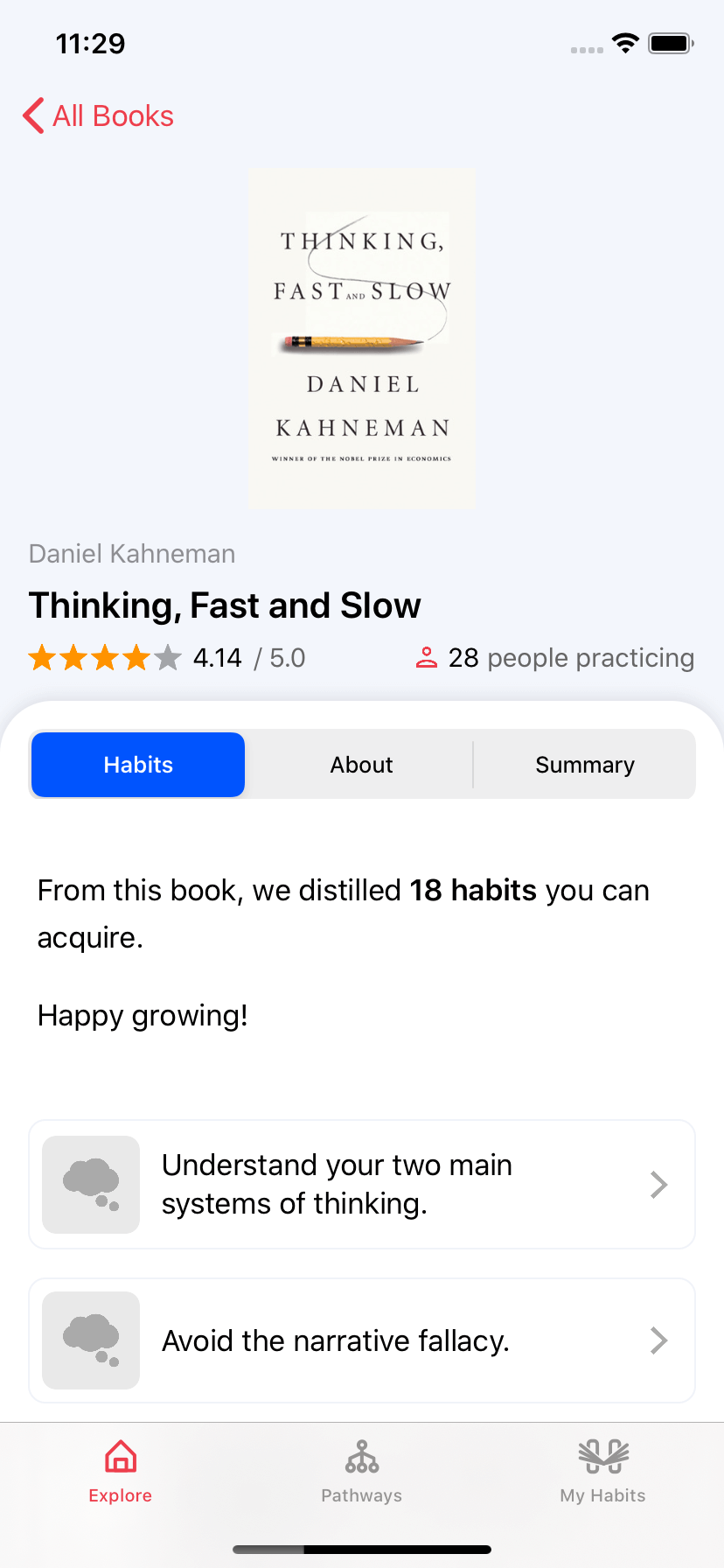
Thinking, Fast and Slow
Read in the App
Full actionable summary
Why do we think the way we do? In Thinking Fast and Slow, Daniel Kahneman takes us on a tour of our minds to reveal the processes and systems that shape the way we think. He explains the abilities and faults of the two main types of thinking, fast and slow, and teaches you how to use each type to your advantage. With practical and enlightening insights into how we make choices - both in a professional and personal context - he reveals just how much our surroundings can influence our thought processes if we allow them to.
What You'll Learn
This summary distills the key insights from Thinking, Fast and Slow into actionable steps you can apply immediately. Perfect for busy professionals who want to learn and implement quickly.
Read in the App
Get the full actionable summary with our mobile app
Key Insights & Chapters
The Characters Of The Story
“We can be blind to the obvious, and we are also blind to our blindness.”
There are two types of thinking, one is fast, and the other is slow. Each type of thinking is its own system with individual abilities, limitations, and functions. The main difference between the two is that fast thinking requires little to no effort to operate, whereas a conscious effort is necessary for slow thinking to work. For example, you would use fast thinking to solve the problem “2 + 2 = ?” and slow thinking to fill out a tax form.
This distinction becomes very important when we realize that attention is not unlimited, and going beyond your budget will likely result in failure. This is why you can only do multiple things at once when they are relatively easy and undemanding tasks, such as speaking to a passenger while driving on an empty road. However, you would not attempt to have a conversation while making a turn onto a busy road as you need to focus your attention on driving.
While your two types of thinking often split the labor between themselves well, they can clash when an automatic reaction (fast thinking) comes into conflict with an intention to control it (slow thinking). One universal example of this is trying not to stare at an oddly dressed couple in the same room as you.
Sometimes, these clashes are caused by cognitive illusions. An example is experiencing a strong attraction toward someone with a history that forms a negative pattern. The good news is that you can overcome these illusions simply by being aware of them and trying to avoid mistakes when the stakes are high.
Actions to Take
Anchors
“Anchoring effects are everywhere.”
The anchoring effect refers to how people tend to consider a particular value for an unknown quantity before estimating that value. When buying a house, for example, you will almost certainly be influenced by the asking price: You think that the same house will be more valuable if the asking price is high and less valuable if it’s low. There are two types of anchoring effects, each corresponding to a thinking type:
-
Anchoring by adjustment- describes the operation of slow thinking, where your mind starts at an anchoring number, assesses whether it is too high or too low, then adjusts the original estimate by mentally “moving” from the anchor. The adjustment typically ends prematurely when you feel like you have “moved” enough.
-
Anchoring as a priming effect - describes the operation of fast thinking, where your mind subconsciously associates something you see, feel or hear with your estimate. For example, consider the following questions:
- Was Gandhi more or less than 144 years old when he died?
- How old was Gandhi when he died?
It is highly unlikely that you would adjust your estimate down from 144 to answer the second question, like with the anchoring by adjustment approach. However, you will likely provide a high estimate, as the first question subconsciously primed your anchor.
Actions to Take
Regression To The Mean
“The feedback to which life exposes us is perverse.”
In statistics, regression to the mean refers to a phenomenon where if a sample of a random variable is extreme, the next measurement will be closer to the mean. This phenomenon is common in real life, too. For example, if someone performs extraordinarily well on one instance, their next try is more likely to be worse, and vice versa.
Now, when someone performs very well at a task, they are likely to be praised or rewarded (and, similarly, punished for poor performance). Due to the regression to the mean phenomenon, the next time they perform that task, they are likely to do worse - making it seem like rewarding them for good performance results in worse performance.
Our intuition often interferes with our ability to make accurate judgments and predictions. It’s a characteristic of fast thinking that typically draws conclusions from base-rate information—that is, the general, generic information you have on the subject.
Since the general information we have on any subject is not always applicable to the decision we need to make, relying solely on intuition isn’t always the right thing to do. Instead, we need to supplement it with factual information and use slow thinking to assess them before making any judgment or decision.
Suppose you see a person reading The New York Times on the subway, for example. If you were to be asked which is more likely to be accurate about this person: she has a Ph.D., or she does not have a college degree—your intuition would probably say she has a Ph.D.
However, in this situation, the fact that she is riding the subway is the information to be considered. Therefore, the second option is more likely to be accurate since more non-graduates than PhDs ride the subway.
By supplementing your gut feelings with hard facts, you’re securing yourself from the negative consequences of your decisions.
Aside from relying on intuition, there are two other phenomena we must avoid in order to avoid making mistakes and failures:
-
Narrative fallacy - a very common phenomenon experienced by each of us. This can lead us to believe things about ourselves that are not necessarily accurate. It occurs due to our brains needing to make sense of our experiences as well as the world around us, so it often embellishes or slightly alters our memory of past events. This, in turn, shapes our perceptions of the world and affects future expectations. For example, it could cause you to have an incorrect perception of yourself and your abilities, causing you to fail at a critical task in the future.
-
The illusion of validity - refers to our tendency to believe our predictions or beliefs are valid just because we feel confident in them. Remember that confidence comes when your beliefs and predictions are easy to process and understand, but this feeling is not a good measure of their validity. So rather than relying on your confidence to determine the accuracy of your beliefs, it’s better to use objective facts. When you buy into the illusion of validity, you risk making mistakes at times when you cannot afford to, keeping you from achieving success.
Now that you’re aware of these phenomena that prevent you from making the right choices and having the right beliefs, it’s time to learn how to make unbiased and accurate predictions through a simple method: using math and factual evidence as your basis.
Actions to Take
Reversals
“The moral intuitions that come to your mind in different situations are not internally consistent.”
The choices you make depend heavily on the context in which you make them. For example, let’s say you are faced with two bets:
-
You have a 30% chance of winning $150, and a 70% chance of losing $15
-
You have a 95% chance of winning $40, and a 5% chance of losing $10
Chances are, you would consider the second bet to be more valuable, as you are much more likely to win it.
Now, let’s say you own that bet: What would be the lowest you would be willing to sell it for? Compare that value to the lowest you would be willing to sell the first bet for. It’s highly likely that you will find that the first bet is of higher value to you now.
To put it simply, you feel differently about the same thing when the context is changed. This phenomenon called “reversals” is the driving force behind many mistakes, and being able to discern the reality of the situation without being influenced by its context is a valuable life skill.
Actions to Take
Get Full Access in the App
Download Mentorist to explore detailed action steps, track your progress, and build lasting habits.

Experience the Full Summary
Read comprehensive summaries and track your progress with our mobile app